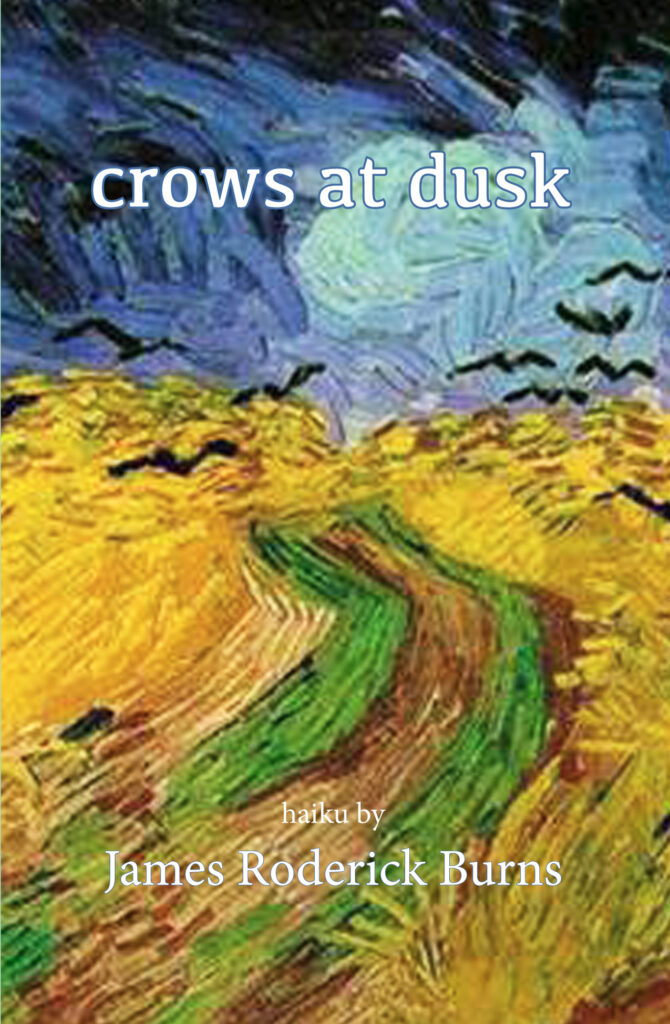
crows at dusk by James Roderick Burns
Red Moon Press (USA)
www.redmoonpress.com $20 (USA)
(112 pages)
The first thing one notices when looking at James Roderick Burns’ haiku collection crows at dusk is its front cover, which features Van Gogh’s Wheat Field with Crows (1890). It can be said, in retrospect, that the swirling power and intensity of this painting evokes a vivid, heightened sense of the kind of work to appear in the book itself. In other words, it’s as if the reader is being presented with a magnifying glass through which they can gain a powerful, preliminary glimpse of what follows.
crows at dusk is divided evenly into five sections: ‘Autumn’, ‘Winter’, ‘Spring’, ‘Summer’ and ‘Autumn (Reprise)’.
The three-line worlds that Burns creates in each poem are most memorably evoked in the ‘Autumn’ section by haiku including
Around the bend
and over the houses
daytime fireworks
and the particularly striking
Flyover –
gnats buzz into the fog
out of the fog
Typically, the natural world is depicted as being in some sense busy; but, if not obviously busy, then, at the very least, not in a static or ossified state. In connection with this, the wabi-sabi aesthetic – in which impermanence is central – is underlined at the outset of the collection in one of its epigraphs, and is in operation throughout the book.
In the haiku of the ‘Winter’ section, the underlying busyness, or, if you like, energy, of the natural world is particularly evident in works such as:
Just as good –
the storied snow goose’s
wild, inky honks
Here, it is not just the honks that are important, but the ‘wild’ inkiness with which they are animated and vivified. Furthermore, in the ‘Winter’ section,
Winter wasp
bustles into the cold, taps
for readmission
underlines a truth of nature that the wasp is not willing to simply lie there, and die there, so to speak. There is always, in some overt or covert way, the fight to live – even if this fight is ultimately doomed to failure.
In the ‘Spring’ section of the collection, the natural world is, appropriately, no busier than the preceding section (a contrast to the cliché that regards spring as the most active season), but, rather, behaves in its characteristically spring fashion, does its work and ultimately moves on to the next seasonal phase. This is implied in ‘
Bumbling
along behind glass
first bee of spring
The implication is that, inevitably, there will be a last bee at a fitting stage in the cycle.
Summer comes, as presented in the ‘Summer’ part of Burns’ collection, if not ‘barbarous in beauty’ à la Hopkins, then, nevertheless, in a vivid, striking manner. This is best exemplified in haiku such as
Mouse body
turned toward home
by the wind
and the particularly beautiful
With equal grace
light falls on both crow
and chorister
In the final section of crows at dusk, ‘Autumn (Reprise)’, there is a sense of the seasonal cycle commencing again, as one might expect:
Stripped umbrella –
over the woodyard fence
wafts of autumn
At the same time, there is a deeper feeling of a world perpetually in action, ongoing and, paradoxically perhaps, yet to happen:
All I long for
lies around the bend
unseen river
The question needs to be put: what about the crows of this collection’s title? These birds play a role in various haiku throughout the book, in each of the demarcated sections, first appearing early in the ‘Autumn’ part:
Two crows joust
for a cigarette end –
hard day
Their final appearance is in the ‘Autumn (Reprise)’ part:
Behind the stump
the black stubble a line
of picketing crows
These birds signify ‘busy nature’, always involved in some action, or on the look out for it. This is, of course, only one important aspect of their presence in this book; more importantly, in Japanese mythology, crows symbolise the will of heaven, and this idea is certainly apposite in a book of haiku where seasons move busily and cyclically, beyond Earth’s control.
In Burns’ crows at dusk, we have an impressive haiku collection of considerable intelligence and power, written by a person with a splendid eye for detail. It is a collection which I believe will benefit from repeated readings – a mark of every high quality work of literature.
Kevin Densley is an Australian poet whose work has appeared in Australian, English and American print journals, as well as numerous online venues. Densley’s latest poetry collection, his fifth, Please Feed the Macaws…I’m Feeling Too Indolent, will be published by Ginninderra Press (Port Adelaide, South Australia) in late 2023.
